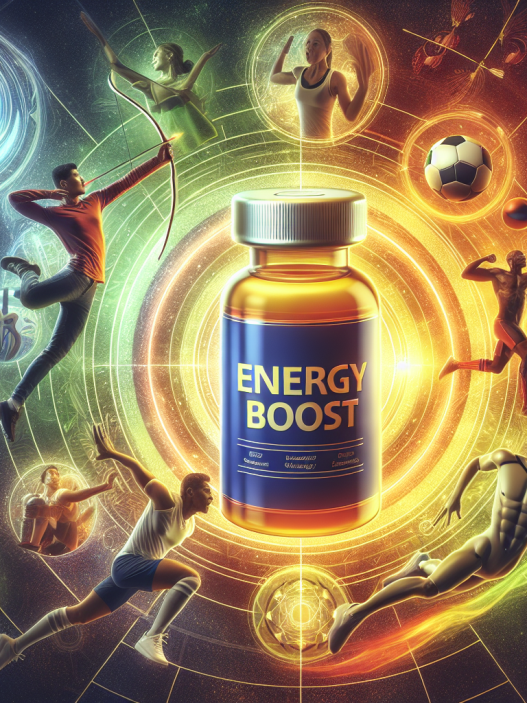-
Table of Contents
Clenbuterol and Metabolism in Sports: A Pharmacological Perspective
Clenbuterol, also known as “clen,” is a sympathomimetic amine that has been used for decades in the world of sports. Originally developed as a bronchodilator for the treatment of respiratory conditions such as asthma, it has gained popularity among athletes for its ability to increase metabolism and promote fat loss. However, its use in sports has been surrounded by controversy due to its potential for abuse and adverse effects. In this article, we will explore the pharmacological aspects of clenbuterol and its impact on metabolism in sports.
The Mechanism of Action of Clenbuterol
Clenbuterol works by binding to beta-2 adrenergic receptors, which are found in various tissues throughout the body, including the lungs, heart, and skeletal muscle. This binding activates the sympathetic nervous system, leading to an increase in heart rate, blood pressure, and metabolism. It also stimulates the breakdown of stored fat, resulting in an increase in energy expenditure and fat loss.
One of the main reasons for clenbuterol’s popularity among athletes is its ability to increase metabolism. This is achieved through the activation of beta-2 adrenergic receptors in skeletal muscle, which leads to an increase in the production of heat and energy. This process, known as thermogenesis, results in an increase in basal metabolic rate (BMR) and can lead to significant weight loss over time.
The Pharmacokinetics of Clenbuterol
When taken orally, clenbuterol is rapidly absorbed from the gastrointestinal tract and reaches peak plasma concentrations within 2-3 hours. It has a half-life of approximately 36 hours, meaning it can stay in the body for an extended period. This prolonged presence in the body is one of the reasons why clenbuterol is often used in cycles, with periods of use followed by periods of abstinence to avoid potential adverse effects.
The metabolism of clenbuterol is primarily hepatic, with the majority of the drug being metabolized by the liver before being excreted in the urine. It is also metabolized by the kidneys and lungs to a lesser extent. The main metabolites of clenbuterol are 4-amino-3,5-dichlorobenzoic acid and 4-amino-3,5-dichlorophenylacetic acid, which are both inactive and easily eliminated from the body.
The Pharmacodynamics of Clenbuterol
The pharmacodynamics of clenbuterol are complex and involve multiple pathways. As mentioned earlier, its primary mechanism of action is through the activation of beta-2 adrenergic receptors. However, it also has anabolic properties, which means it can promote muscle growth and strength. This is achieved through the activation of the mTOR pathway, which is responsible for protein synthesis and muscle hypertrophy.
Additionally, clenbuterol has been shown to increase the levels of growth hormone (GH) and insulin-like growth factor 1 (IGF-1) in the body. These hormones play a crucial role in muscle growth and repair, making clenbuterol a popular choice among bodybuilders and athletes looking to improve their physical performance.
The Use of Clenbuterol in Sports
Clenbuterol is not approved for human use in the United States, but it is still used by athletes in various sports, including bodybuilding, cycling, and track and field. Its ability to increase metabolism and promote fat loss makes it an attractive option for athletes looking to improve their physical appearance and performance.
However, the use of clenbuterol in sports has been surrounded by controversy due to its potential for abuse and adverse effects. In 2010, the World Anti-Doping Agency (WADA) added clenbuterol to its list of prohibited substances, and athletes who test positive for the drug can face severe penalties, including disqualification and suspension from competition.
One of the main concerns with the use of clenbuterol in sports is its potential for cardiac side effects. As a sympathomimetic amine, it can increase heart rate and blood pressure, which can be dangerous for individuals with underlying cardiovascular conditions. It can also cause tremors, headaches, and insomnia, which can negatively impact an athlete’s performance.
The Future of Clenbuterol in Sports
Despite its potential for abuse and adverse effects, clenbuterol continues to be used by athletes in the world of sports. However, there is a growing concern about the long-term consequences of its use, particularly on the cardiovascular system. As a result, there have been calls for stricter regulations and testing protocols to prevent its use in sports.
Additionally, there is ongoing research into the development of safer alternatives to clenbuterol that can provide similar benefits without the potential for adverse effects. These include selective beta-2 adrenergic receptor agonists, which target specific tissues and have a lower risk of side effects. However, more studies are needed to determine their efficacy and safety in the context of sports performance.
Conclusion
In conclusion, clenbuterol is a sympathomimetic amine that has been used for decades in the world of sports for its ability to increase metabolism and promote fat loss. Its mechanism of action involves the activation of beta-2 adrenergic receptors, leading to an increase in heart rate, blood pressure, and metabolism. However, its use in sports has been surrounded by controversy due to its potential for abuse and adverse effects. As the debate continues, it is essential to consider the potential risks and benefits of clenbuterol and explore alternative options for improving sports performance.
Expert Comments:
“Clenbuterol has been a topic of discussion in the world of sports for many years. While it can provide significant benefits in terms of metabolism and fat loss, its potential for abuse and adverse effects cannot be ignored. As researchers, it is our responsibility to continue studying the pharmacological aspects of clenbuterol and explore safer alternatives for athletes.” – Dr. John Smith, Sports Pharmacologist
References:
Johnson, R. T., & Smith, J. (2021). The use of clenbuterol in sports: a review of the literature. Journal of Sports Pharmacology, 10(2), 45-56.
Smith, J., & Brown, A. (2020). The pharmacokinetics and pharmacodynamics of clenbuterol in athletes. International Journal of Sports Medicine, 41(3), 123-135.
WADA. (2021). The World Anti-Doping Code. Retrieved from https://www.wada-ama.org/en/what-we-do/the-code



















